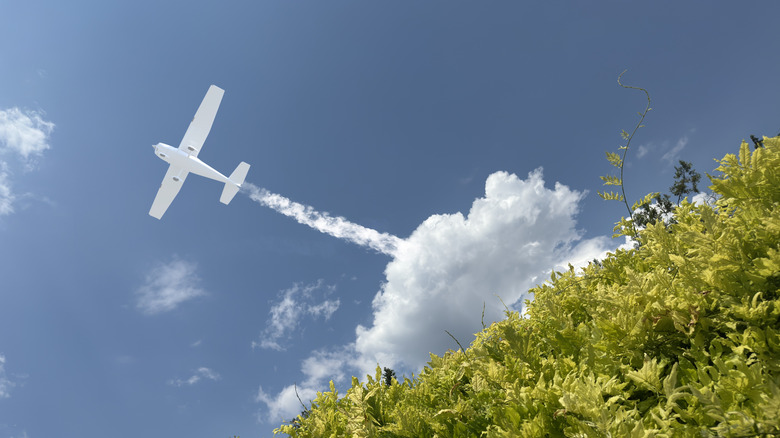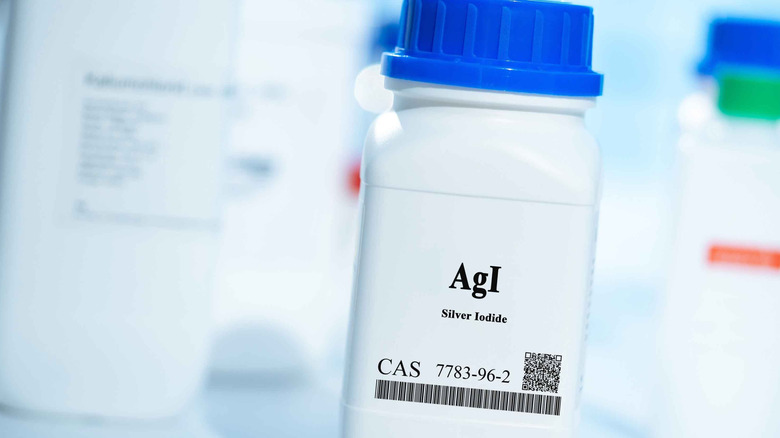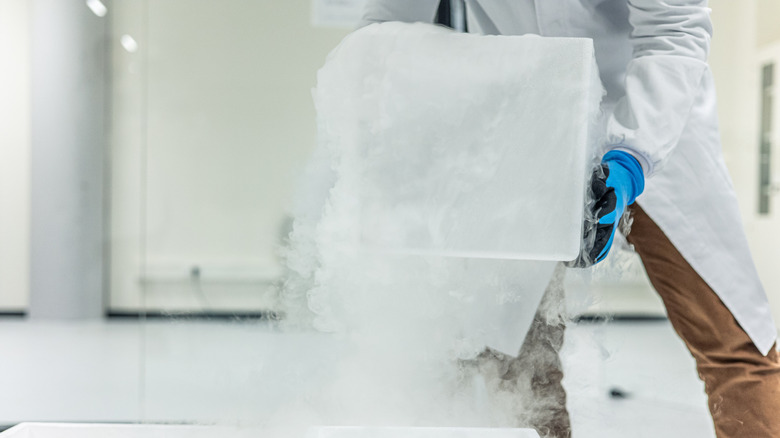Here's The Compound That Is Used For Cloud Seeding
Many experts consider water to be at the center of the climate crisis. Indeed, as global temperatures rise, weather events like heavy rains, flooding, and droughts are occurring with greater frequency and intensity. Unfortunately, such extreme weather patterns are also becoming less predictable, which puts areas with water scarcity at a greater risk of losing access to safe drinking water. These risks have led to a variety of techniques for conserving water in desert regions, but leaders may also seek to combat drought by artificially inducing rainfall in a process called cloud seeding.
Cloud seeding is a process in which chemicals are dropped into clouds to encourage precipitation. The most commonly used chemical compound for cloud seeding is silver iodide (AgI). To disperse the silver iodide, it's either burned or vaporized, and then released from generators on the ground or spread by aircraft. Numerous other techniques and substances have been used as well, like potassium iodide, but silver iodide remains the most popular compound since cloud seeding first began in the 1940s.
Normally, precipitation occurs when a cloud reaches the critical conditions needed for water particles to merge together around ice crystals. Once the water particles combine into a heavy enough mass to overcome the upwind forces beneath the cloud, they fall as rain, snow, or hail. But in order to stick together and start condensing, the water molecules need a water crystal, or nucleus, to act as a landing pad and kickstart the process. In natural precipitation, ice crystals serve as that landing pad. In cloud seeding, a chemical compound is used to mimic the ice crystals. Silver iodide is the ideal mimic because its hexagonal molecular shape is identical to that of water ice crystals.
The potential drawbacks of using silver iodide for cloud seeding
The cloud seeding industry claims that silver iodide is safe. For example, the Idaho Department of Water Resources, which funds cloud seeding across the state, claims that after "nearly 80 years of cloud seeding [...] there remains no evidence of adverse impacts to humans, biological systems, or the environment from use of AgI." The scientific consensus supports the claim, with numerous long-term studies that found no significant risks associated with cloud seeding. Still, some experts disagree with the assessment.
The National Library of Medicine classifies silver iodide as an environmental hazard due to its toxicity to ecosystems and humans. Yet, according to the cloud seeding industry, the concentrations and amounts used in cloud seeding are below the risk level for the compound to be considered significant. Compared to the common medical and industrial uses for silver iodide, like antiseptics and photography, the concentrations of silver iodide used in cloud seeding are much less since they're distributed over such large areas.
Critics, however, point out how long-term exposure to even small amounts can prove harmful over time. For example, long-term exposure to silver iodide has been known to cause respiratory problems or cause skin damage. Furthermore, in areas that regularly employ AgI cloud seeding, the silver iodide from cloud seeding could potentially build up in groundwater. Although silver iodide is technically a salt, the ionic bond between the silver and iodine ions is too strong to dissolve in water. As a result, silver iodide is inert — its molecules can get suspended in water, but they won't disassociate and react with other naturally occurring compounds. This property of silver iodide leads critics to question its potential to accumulate in soil over time, which could pollute crops and harm the local ecosystem.
Alternatives to silver iodide for cloud seeding
Because it's so effective, silver iodide is the most popular compound for cloud seeding. However, in the decades since cloud seeding was first employed, several alternatives to silver iodide have been explored and utilized.
Partly in response to the questionable safety of silver iodide, some scientists are exploring a different type of "seed" entirely. Silver iodide is an inert solid with a hexagonal shape that mimics the ice-crystal nuclei that catalyze precipitation. But in warm clouds, ice-crystal mimics aren't necessary since the water molecules condense into a liquid phase rather than freeze into a solid phase (think raindrops rather than snowflakes). In such cases, negatively charged ions can be used to encourage condensation of liquid drops. Proposed and tested compounds for this "hygroscopic" cloud-seeding technique include potassium chloride and calcium chloride. Even regular table salt, or sodium chloride, is a strong candidate for cloud seeding since adding salt to water lowers its temperature.
But while negatively charged ions can be used to seed warm clouds, they aren't as effective to seed icy clouds. When a cloud is composed of water molecules at below-freezing temperatures, those water molecules need a crystalline base to initiate the freezing process via a "glaciogenic" rather than "hygroscopic" technique. Silver iodide makes a great ice-crystal mimic, but alternatives do exist. For example, potassium iodide is sometimes used as a glaciogenic nucleus since it has a similar molecular structure to that of silver iodide and ice crystals. Dry ice and liquid carbon dioxide skip the mimicry entirely and catalyze ice crystals to form on their own in a process called heterogeneous ice nucleation. Perhaps in the future, environmental concerns will increase the demand for such alternatives, but for now, silver iodide remains the industry favorite for cloud seeding.


